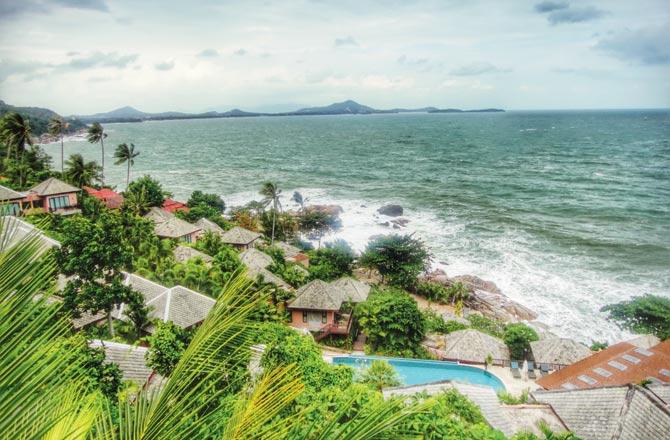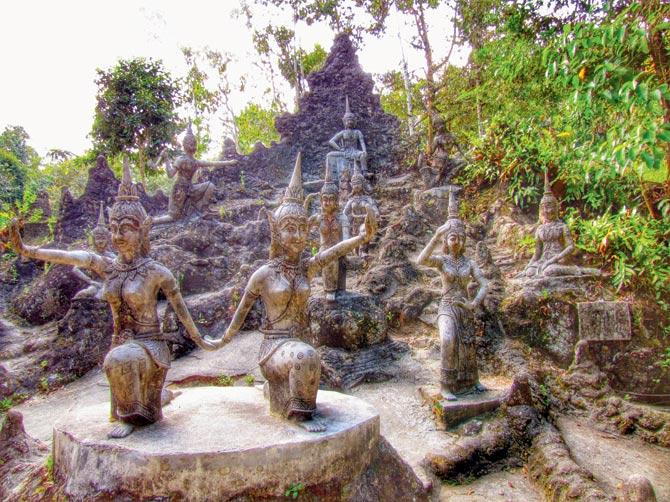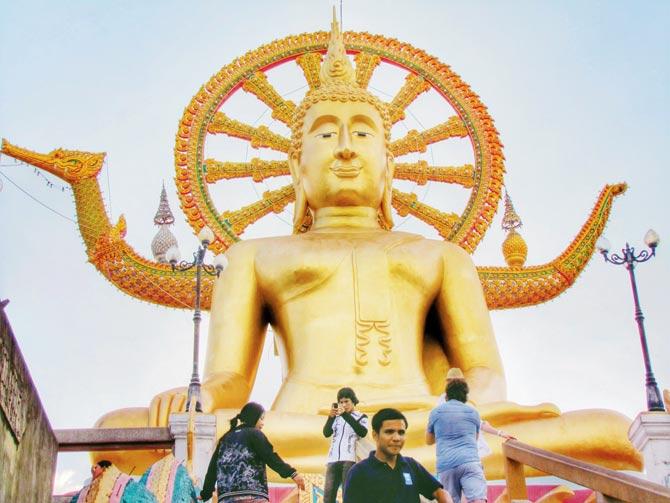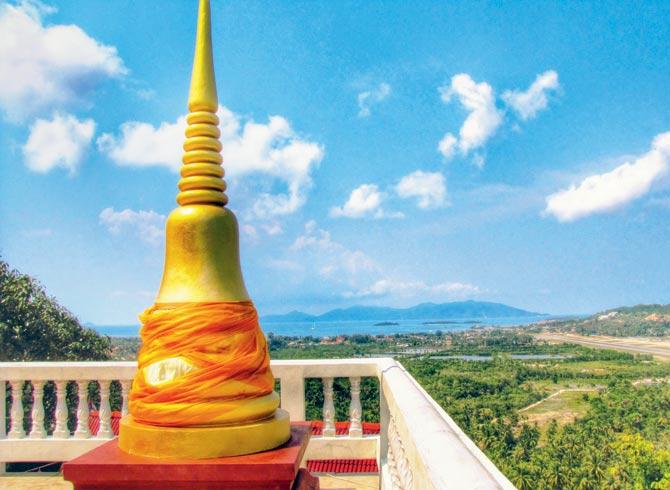The charming island of Koh Samui has something for everyone — beach bums, food connoisseurs and history enthusiasts. Kalpana Sunder explores the island and discovers that it’s a true paradise on Earth

There is something about Koh Samui. It seems to tick all the right boxes. White sand beaches? Check. Blue skies, glorious sunsets and life in the slow lane? Check. Even its airport — an unexciting building in any other part of the world — resembles a tropical paradise with landscaped gardens and palm tree pillars, complete with small vehicles that look like toy trains to ferry passengers. Even the baggage belt is housed in a thatched hut!
ADVERTISEMENT

A view of the Samui coast. Pics/Kalpana Sunder
On arriving at Koh Samui, I head to my hotel near the Chaweng Beach, which is at the heart of the island. After checking in, I head to the idyllic beach, where its white sand feels like silken powder against the skin of my bare feet. While I take in the sight of canopied beds offering cheap reflexology massages, hawkers offer to braid my hair or take me on colourful, red and green kayaks for a ride through the shallow waters of the lagoon. Beach loungers line the beach shore and children build sandcastles as crabs scuttle under their feet. Several restaurants offer to serve the fresh catch of the day on one of its many dining tables placed strategically by the beach. You can also munch on roasted corn on the cob, in between long gulps of the local beer.

The ribald Grandfather Rocks
Meeting Buddha
Long ago, the sleepy island of Samui attracted fishermen from mainland Malaysia and China in droves. The island — which was also called ‘Coconut Island’, thanks to the cotton and coconut that it produced — became a favourite haunt of backpackers in the early 70s. When the island’s airport opened in 1989, hotels and guesthouses began to get constructed here on a large scale.

The magical Tanim Magic Garden with figures frozen in stone
Over the next few days, we explore the island on mopeds hired from roadside stalls. Palm fronds sway in the balmy monsoon wind as I whiz down the coastal road. The ride offers us great views of the sea, iridescent green banana and palm plantations, hidden coves, sparkling waterfalls, small temples and miniature spirit houses laden with flowers.

The island’s Big Buddha
I climb down to Tanim Magic Garden, where a retired durian farmer has created a sculpture garden with deities from Buddhist mythology and fantasy creatures from the Ramayana in stone — traipsing through the nubile dancers and sculptures set on a hill, feels like wandering in fairyland. A tree-lined stone stairway leads the way into a jungle gorge, where I spend a couple of hours meandering through the forest, catching glimpses of stone figures, frogs and tortoise scattered amongst the greenery and gurgling streams.

Small spirit houses, with flowers and offerings
In the evening, we head to Chaweng town which is a sprawl of thumping discos, go-go bars, stalls selling faux designer jeans and sunglasses, convenience stores 7 Elevens, ready-in-a-day tailors and massage houses offering traditional to raunchy massages. ‘Ladyboys’ strut around confidently, while loudspeakers from vans announce and advertise upcoming Thai boxing matches.

View from the top-Khao Hua Jook
At the northern end of the island, on a small island linked by a causeway, is the towering Buddha or Wat Phra Yai gilded with gold. Its 15 meters tall and perched on the island like a protective guardian, ringed by souvenir stalls. We also visit the quirky Wat Khunaram, where a mummified monk, who died while meditating, is closed in a glass coffin — his mudra pose, orange robes and Ray ban sunglasses undisturbed.
Off the beaten path is Wat Sumret — a serene temple inhabited by only a handful of monks. A weathered building houses an eerie congregation of old Buddha statues clothed in orange robes. The visit takes a rather ribald turn with the Grandfather and Grandmother Rocks called Hin Ta and Hin Yai, which are perched provocatively at the southern end of the Lamai Beach. They resemble the male and the female
sex organs! According to folklore, an elderly couple went out to sea and their boat capsized in a storm. The couple died and turned into rocks to be remembered forever.
Trek or scuba diving
I love the bohemian feel of Bophut Fishermen’s village where old teak houses, converted into atmospheric bars and restaurants as well as upmarket boutiques lend the place a Mediterranean touch. The main ‘walking street’ runs parallel to the beach so you can opt for cheap, freshly cooked snacks offered by hawkers and the eclectic restaurants whose balconies skirt the white sandy beach and its cerulean waters. There are also diving schools that offer diving equipment and lessons to adrenaline junkies.
For a whiff of something different, I head to Baan Hua Thanon, or the ‘Muslim Village’, for its traditional wooden storefronts, colourful long-tailed fishing boats docked at the harbour and splendid sunsets. However, if being a beach bum is not your thing, there are other pursuits as well. You can take a day trip to the 42 islands of the Ang Thong National Park with the clearest of waters to snorkel, scuba or sea-kayak. Or, plan a trek to one of the island’s many dense forests and a zip line ride through the canopies.
Towards the end of our trip, we head to Khao Hua Jook, a golden pagoda perched on a hill, which offers a bird’s eye view of the island. I gaze at the white beaches, palm-fringed bays, forested hills, smudges of coral reefs and the aquamarine ocean. I try to take a mental snapshot of the scene as this is exactly how I would like to remember the island in the years to come — as the paradise on Earth that it truly is.
Fact File
Getting there: Fly to Bangkok and take a Bangkok Airways flight to Samui. (about one hour)
Stay: Amari Palm Reef Resort in the secluded northern end of Chaweng Beach and 10 minutes from the Airport with 187 Thai-style rooms set in tropical gardens and beach front with two swimming pools, three restaurants, the Sivara Spa and a Dive Centre
Buy: Souvenirs made out of coconut shell, soap carvings and local coconut and sticky rice toffees called Caramae
Eat: Local Thai food is found almost everywhere. There are also Mexican, Italian and Indian restaurants in Bophut. Try the Italian food at Prego at the Amari Palm Reef Resort
 Subscribe today by clicking the link and stay updated with the latest news!" Click here!
Subscribe today by clicking the link and stay updated with the latest news!" Click here!






